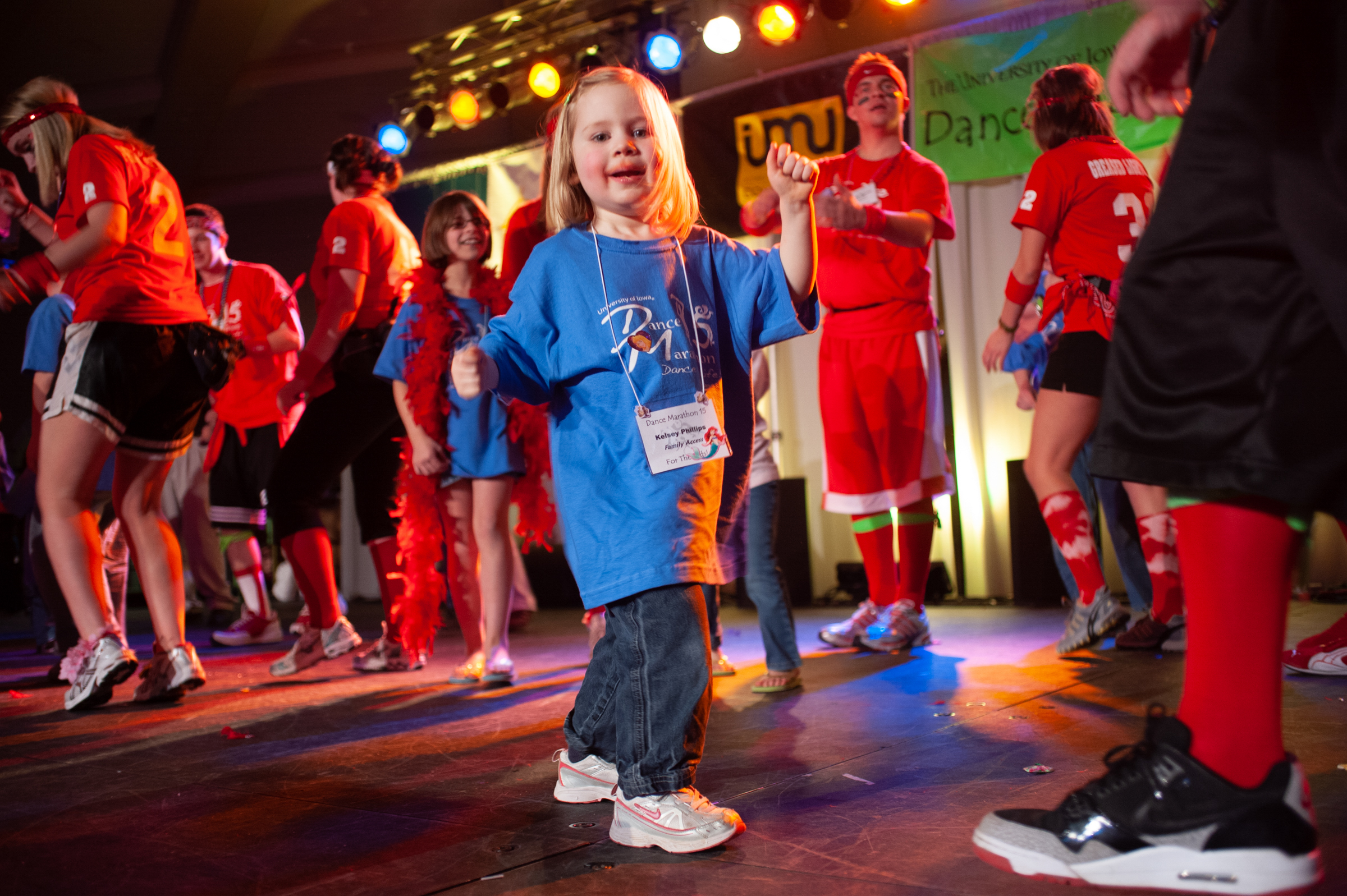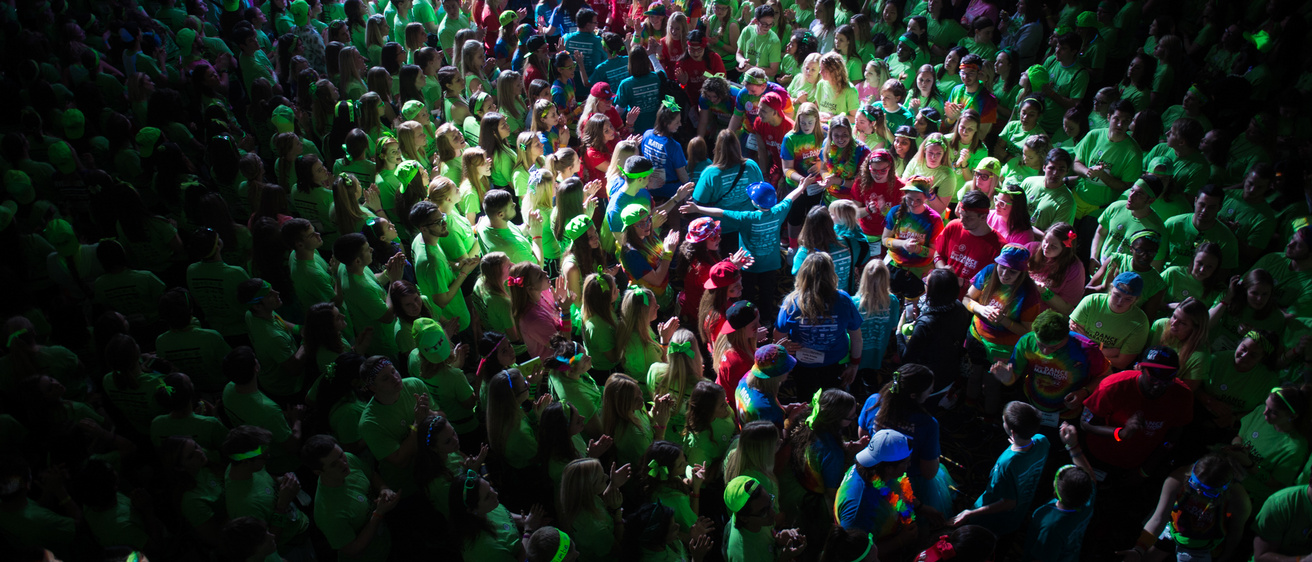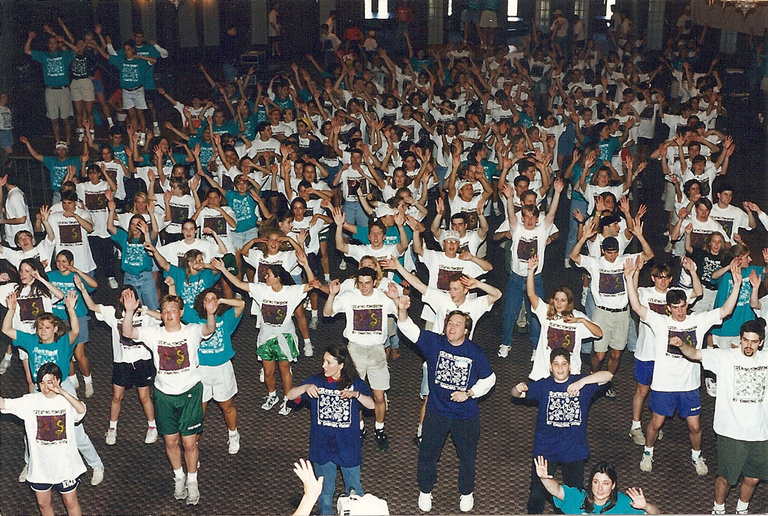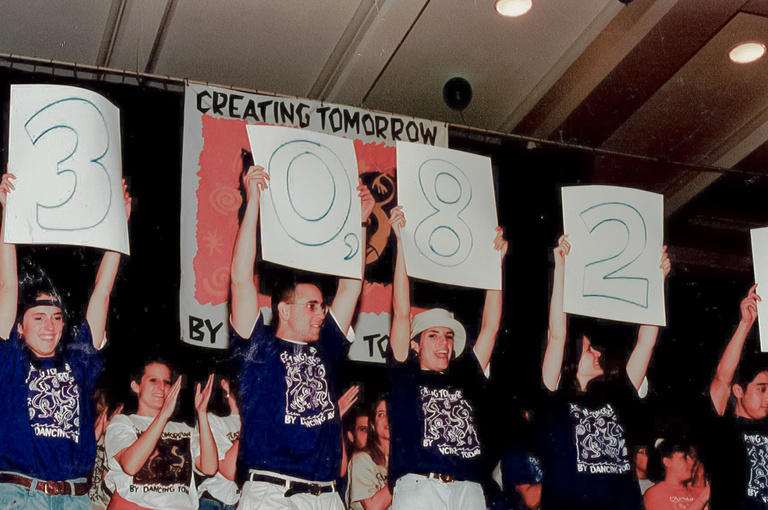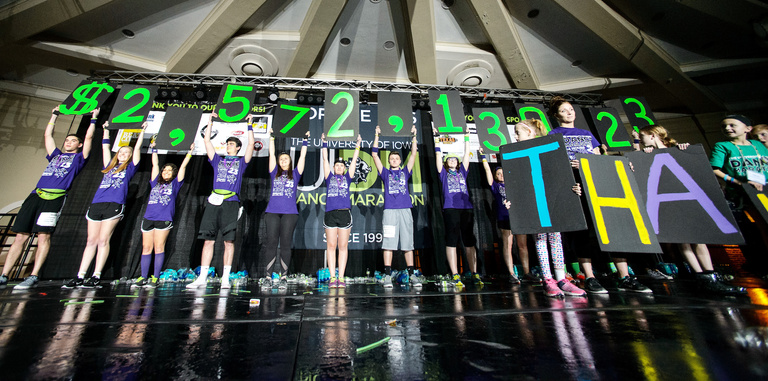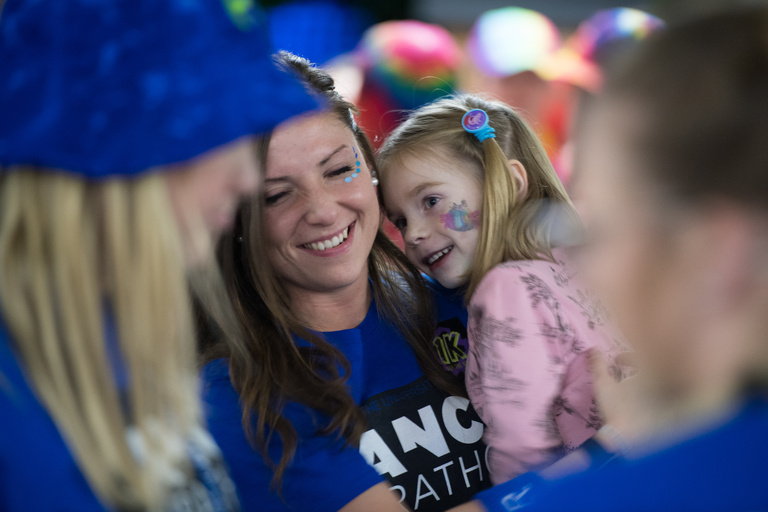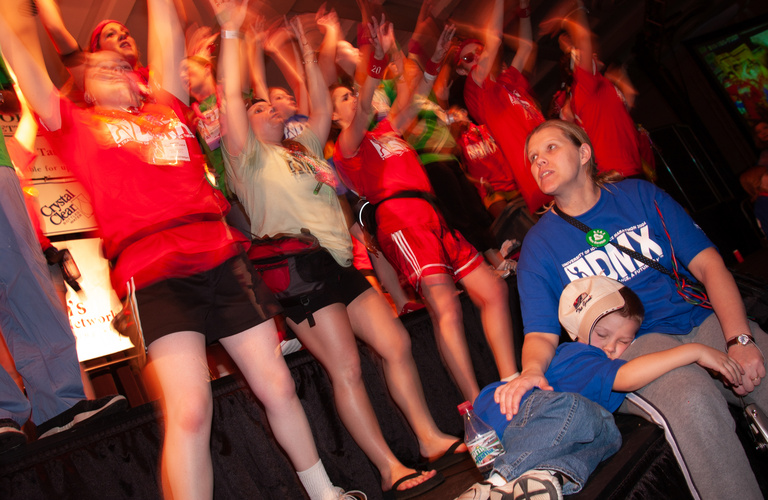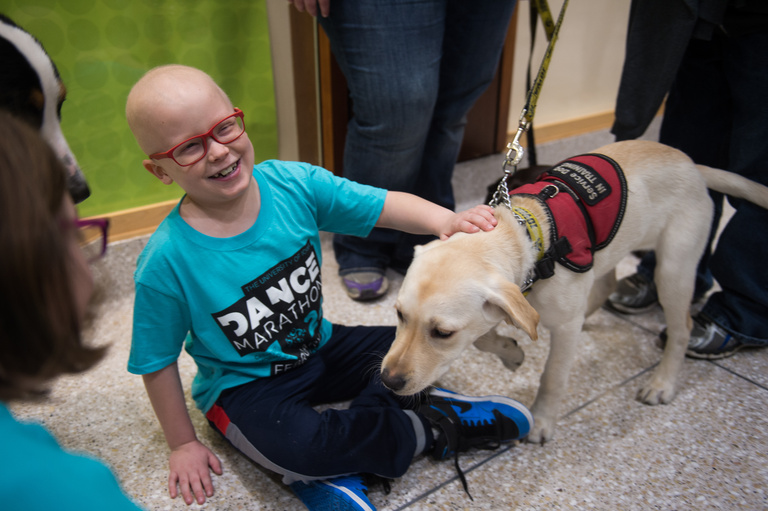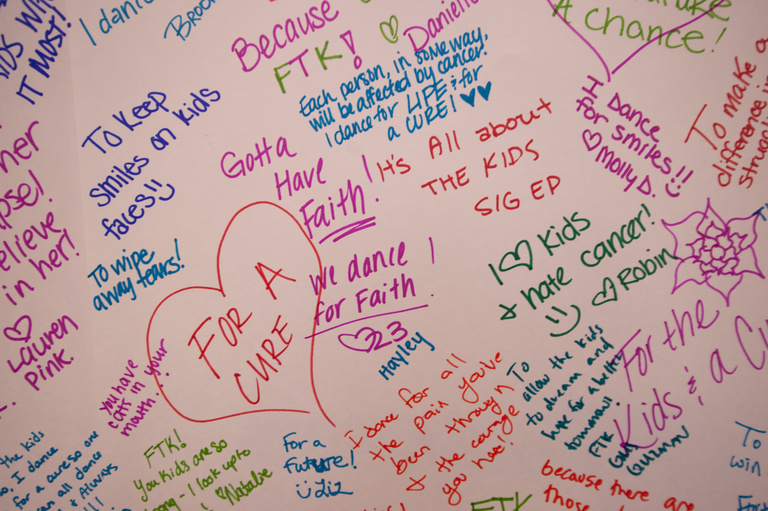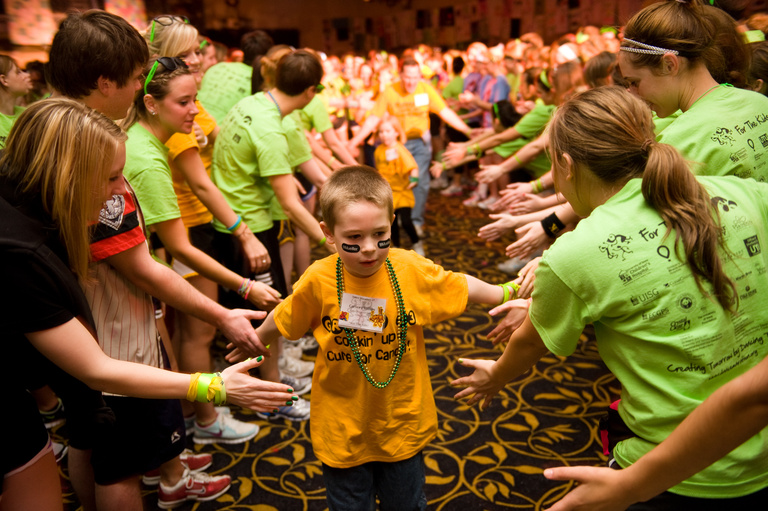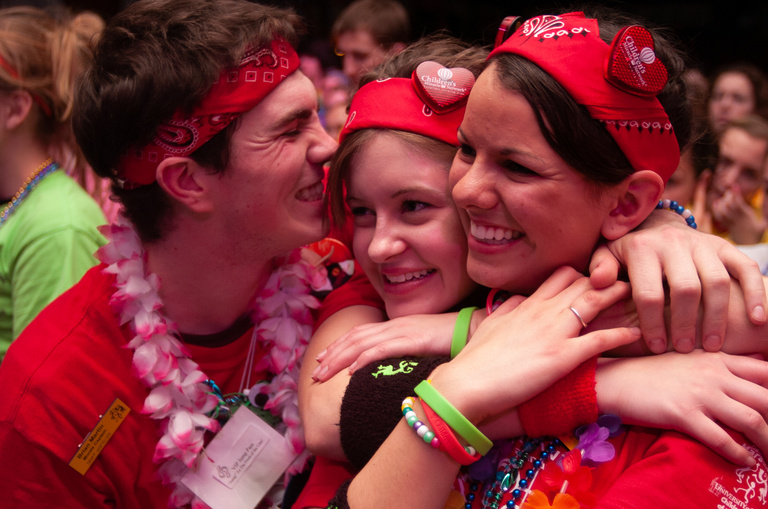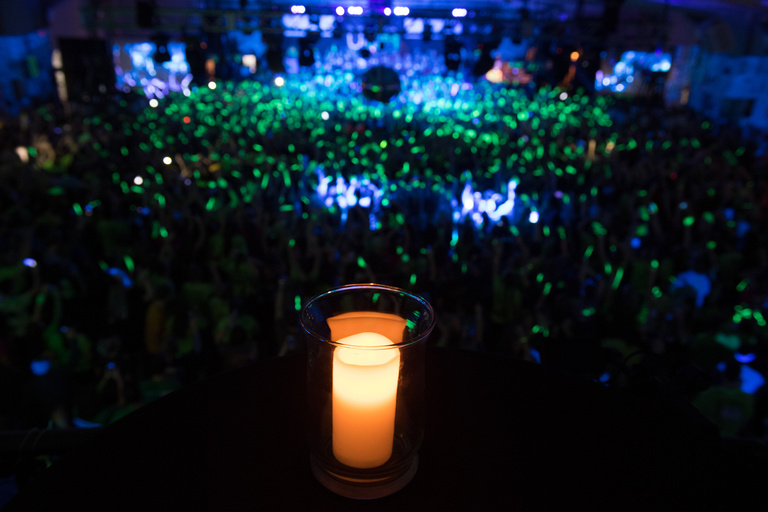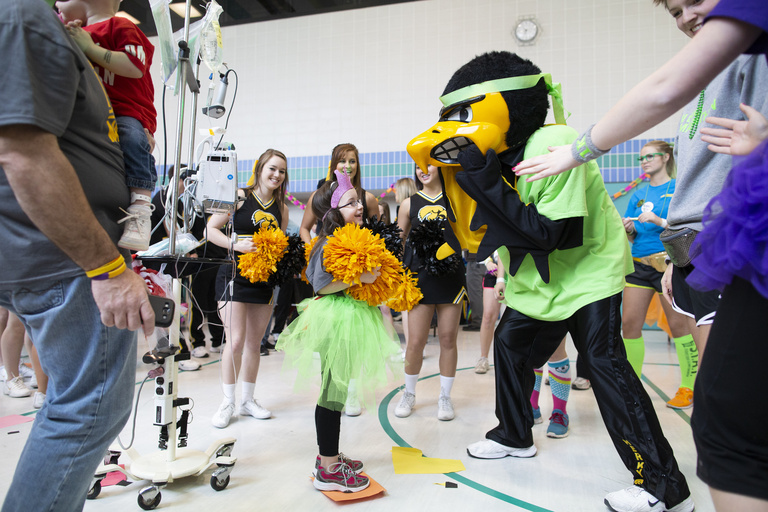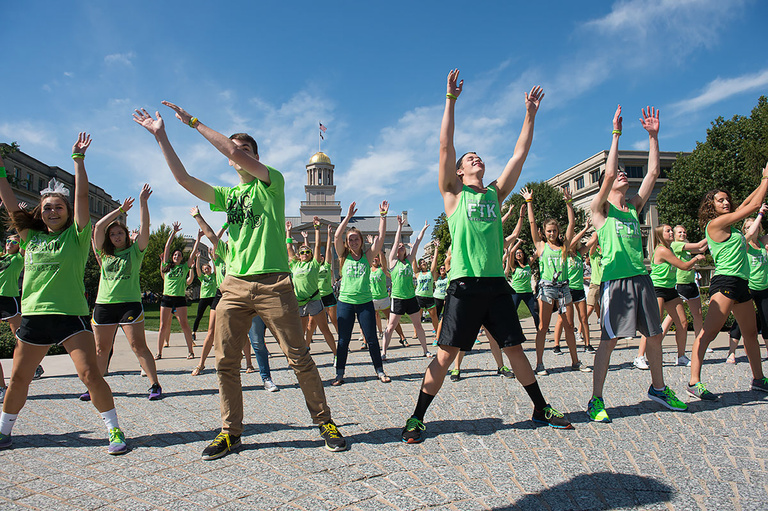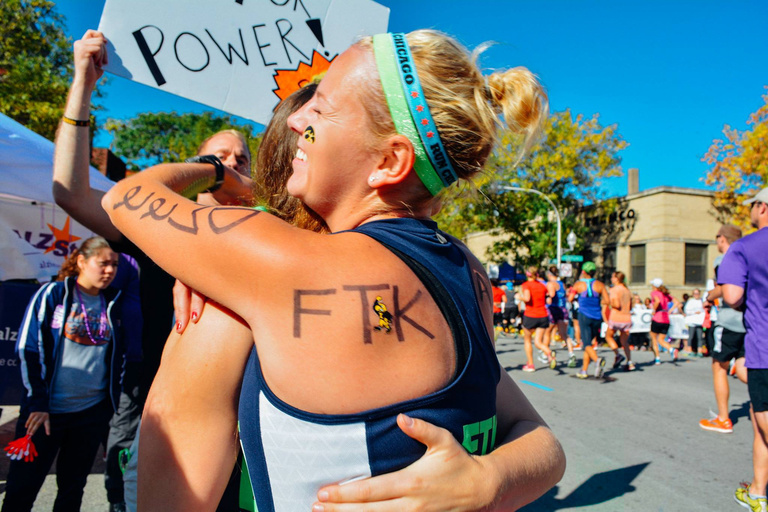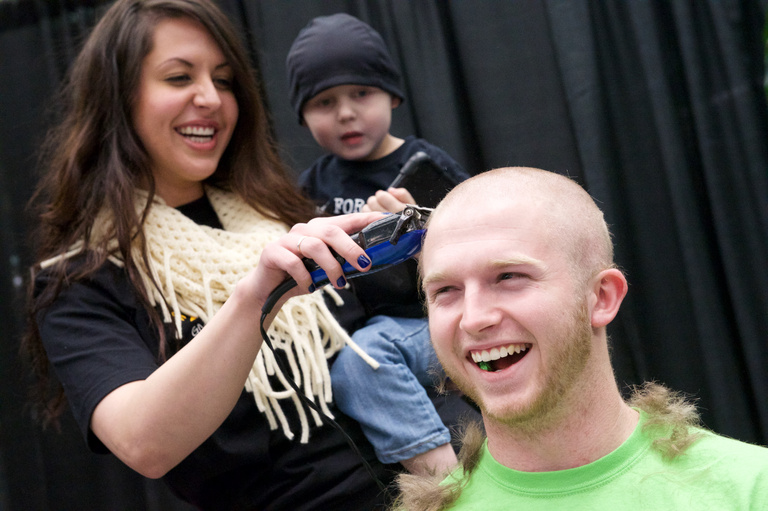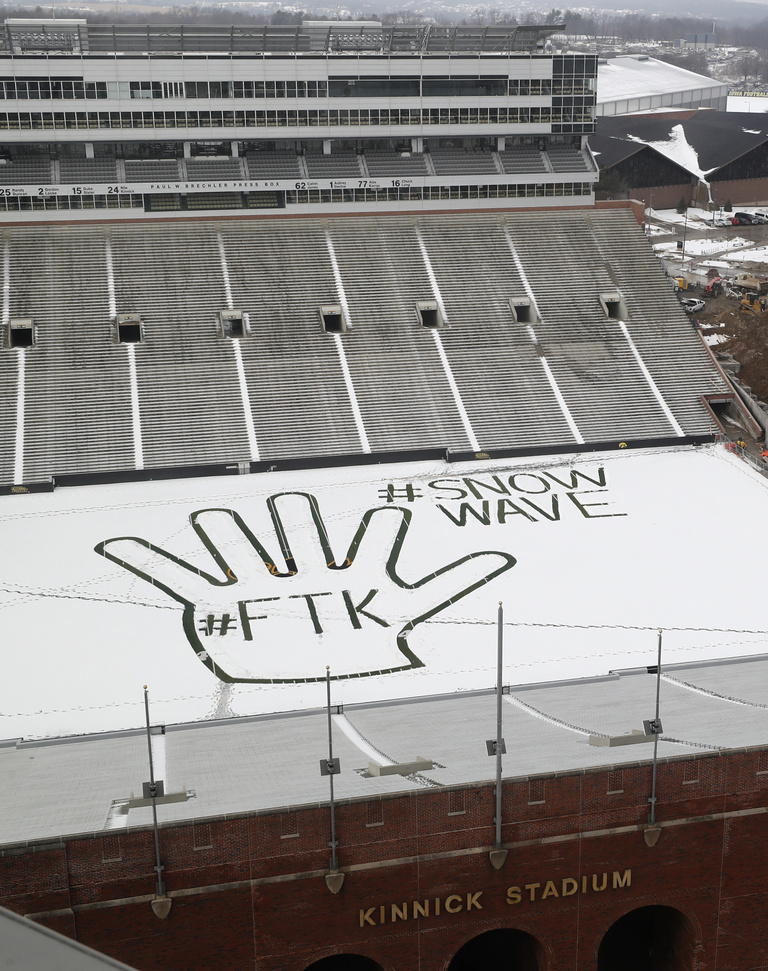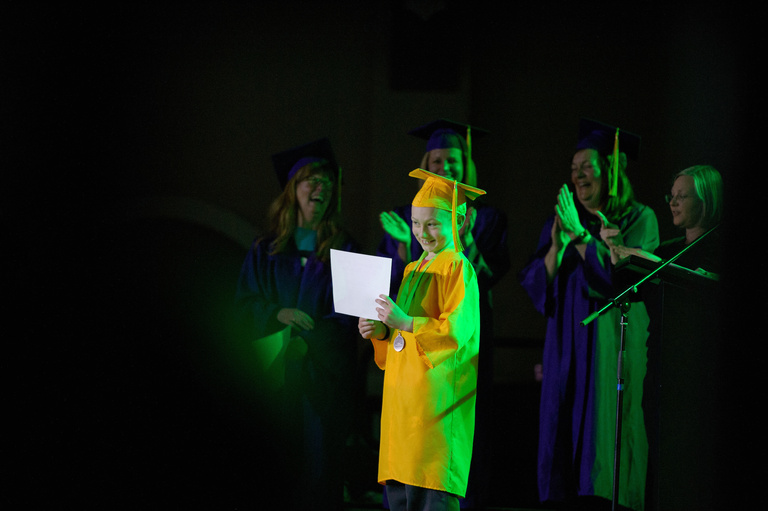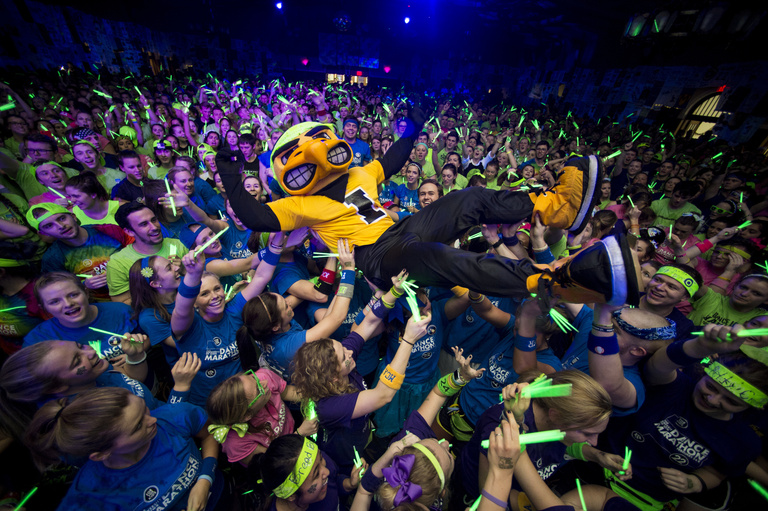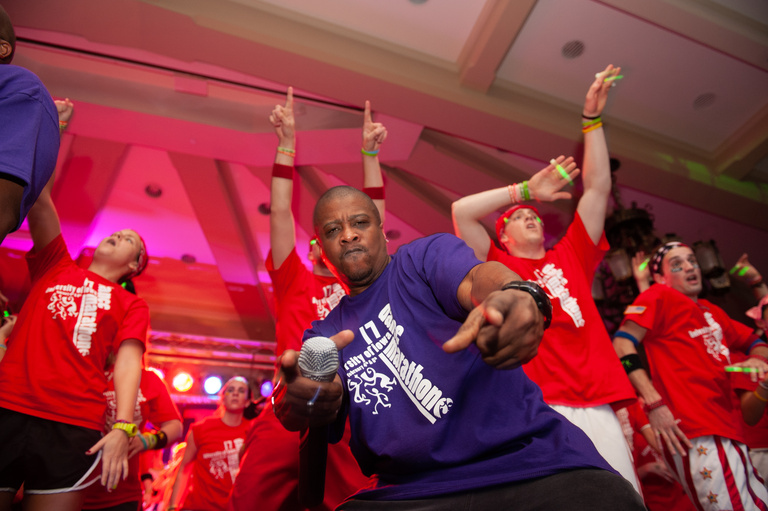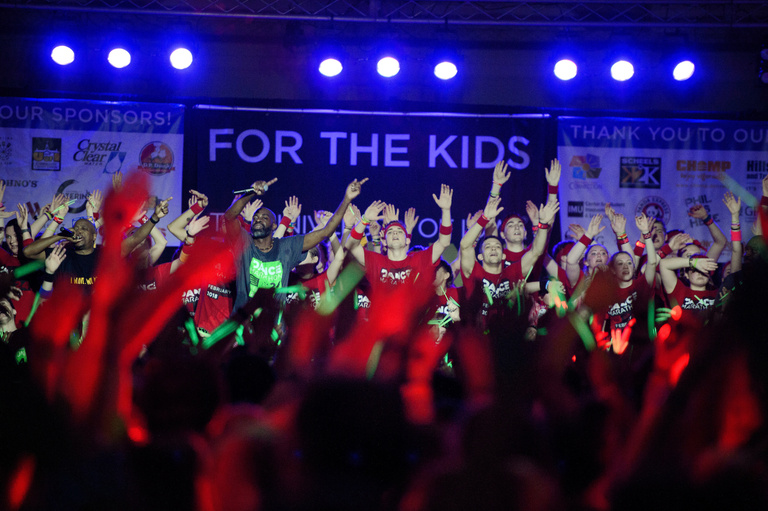University of Iowa Dance Marathon has become one of the largest college philanthropies in the country—and it is starting to have a significant impact on the race to cure and prevent pediatric cancer.
Story: Sara Epstein Moninger
Photography: Tim Schoon, Justin Torner, Brian Ray, University of Iowa Health Care, and courtesy of UI Dance Marathon, Brandy Valyer, and Sheila Baldwin
Video: UI Dance Marathon
Published: Jan. 16, 2019
The numbers alone are impressive: nearly $3 million raised in 2019, more than $27 million overall, some 3,000 student participants, and more than 950 families served.
Many in the University of Iowa community are at least somewhat familiar with what Dance Marathon does. It’s a student-run organization that raises money to support pediatric oncology patients and their families at the UI Stead Family Children’s Hospital. The yearlong effort culminates in “the Big Event,” a 24-hour dance marathon held each winter at the student union, where they reveal the amount raised in the previous 12 months, celebrate young cancer survivors, and remember those lost.
Throughout the year, students donning lime-green Dance Marathon T-shirts frequently are seen busking for change on the Iowa City pedestrian mall or entertaining a crowd as they perform a flash mob on the Pentacrest. They maintain a regular and reliable presence as volunteers at the hospital, playing Monopoly or shooting Nerf guns with young oncology patients and giving their families badly needed respite.
The commitment doesn’t stop there. The students plan field trips to theme parks for the patients and arrange summer camps. They run the Chicago Marathon because if children can spend their days in a hospital fighting for their lives, they can push themselves to run 26.2 miles and bring in a few more bucks to the cause.
Dollar by dollar, sometimes quarter by quarter, the students solicit donations in Iowa City and in their hometowns, door-to-door, and online. As the Dance Marathon mantra proclaims, these efforts are “for the kids,” or FTK. But since the organization first formed on campus in 1994, under the guidance of the Children’s Miracle Network, its role has evolved.
The money raised continues to fund things like gas cards for families who travel long distances to seek treatment, purchases of laptops and tablets for patient use in the hospital, tuition scholarships for survivors who enroll at the UI, and much more. But in recent years Dance Marathon’s student leaders have set their sights higher, making multimillion-dollar contributions that aim to advance science and conquer pediatric cancer altogether.
UI Dance Marathon donations
Fall 2018: $2.2 million to support a child life specialist in the UI Stead Family Children’s Hospital
Fall 2017: $2 million to establish the UI Dance Marathon Chair in Pediatric Oncology, Clinical and Translational Research
Spring 2017: $653,000 to cover a portion of the costs for a state-of-the-art MRI machine
Fall 2014: $2.2 million to create the UI Dance Marathon Pediatric Oncology Targeted Therapy Program
Spring 2011: $5 million toward building the UI Stead Family Children’s Hospital (11th floor is named the UI Dance Marathon Pediatric Cancer Center)
Spring 2010: $1 million to establish the University of Iowa Dance Marathon Pediatric Cancer and Blood Disorders Research Lab
Significant contributions, significant momentum
Yatin Vyas attends Dance Marathon’s Big Event every year. As vice chair of research in the Stead Family Department of Pediatrics and director of pediatric hematology/oncology at the UI Stead Family Children’s Hospital, he gets to go onstage to announce the start of the event with an FTK chant. It’s a moment he relishes.
Not only is it empowering and exciting, it underscores what Vyas wants to accomplish here: make Iowa the best pediatric cancer treatment center in the Upper Midwest and one of the best in the nation. It’s something he thinks he can do with the financial support of Dance Marathon.
“I came across Dance Marathon as I interviewed for this position and was a bit startled, honestly,” says Vyas, who came to the UI in 2013 after spending years as a faculty member at both UMPC Children’s Hospital of Pittsburgh and Memorial Sloan Kettering Cancer Center in New York. “I had never heard of college students who were so committed to bringing such a change to pediatric cancer. Without a doubt it influenced my decision to come here. Many places I interviewed had similar incentives and startup packages, but the difference at Iowa was UIDM.”
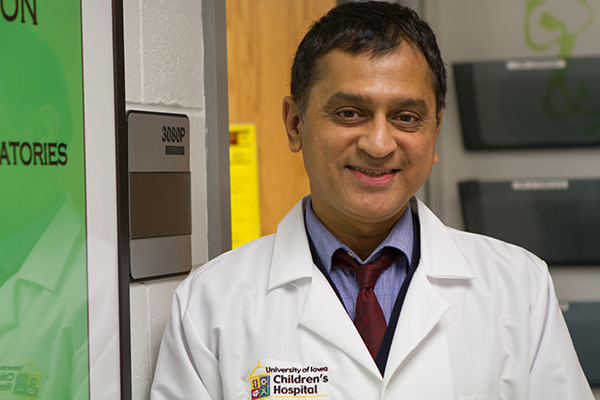
Yatin Vyas
On that initial visit, Vyas toured the university’s cancer research labs, which had recently been renovated with $1 million from Dance Marathon. The contribution marked the organization’s largest single gift at that point—and a shift toward prioritizing pediatric cancer research.
“Everything we are doing here is possible because Dance Marathon is partnering with us. All you need is a little bit of support—a little nudge, some pilot funding—and then you can gather steam by bringing in the best people and building programs. At the minimum, Dance Marathon is providing us the ignition that we badly needed.”
“In pediatric cancer, the care you provide is defined by the innovations that come about in the laboratories, and I wanted to have a solid laboratory structure available for us to do cancer research,” says Vyas, who drafted a new organizational chart for the pediatric cancer division upon his arrival. “When I saw the cancer laboratory here, I was quite amazed and I knew I would have no problems recruiting outstanding pediatric cancer biologists and physician-scientists to the program.”
He was right. To date, Vyas has plucked 10 new faculty members from top national programs, including Sloan Kettering, St. Jude Children’s Research Hospital in Memphis, Texas Children’s Hospital/Baylor College of Medicine, and Boston Children’s Hospital. They came not because they have family in Iowa, he says. Instead, they were attracted to the program’s momentum—much of which he says is fueled by Dance Marathon’s efforts.
$ 2.96 M
$ 27.5 M
2,800 +
In addition to subsidizing the lab renovation and committing $5 million to building the UI Stead Family Children’s Hospital, which opened in 2017, Dance Marathon has supported the professional development and training of hospital staff, fellows, and junior researchers in pediatric oncology; helped purchase an advanced MRI machine; and established a targeted therapy program that treats pediatric cancer patients using personalized medicine. In 2017, the organization donated $2 million to create the first student-funded faculty chair position at the university, the UI Dance Marathon Chair in Pediatric Oncology, Clinical and Translational Research.
With this trust and support from Dance Marathon, Vyas says he is hopeful and confident that Iowa will make a dent in pediatric cancer.
“Everything we are doing here is possible because Dance Marathon is partnering with us,” says Vyas, noting that U.S. News & World Report now regularly ranks the UI pediatric cancer program among the 50 best in the nation. “All you need is a little bit of support—a little nudge, some pilot funding—and then you can gather steam by bringing in the best people and building programs. At the minimum, Dance Marathon is providing us the ignition that we badly needed. I think because of them, this place will one day be an absolutely outstanding place for cancer treatment and research.”
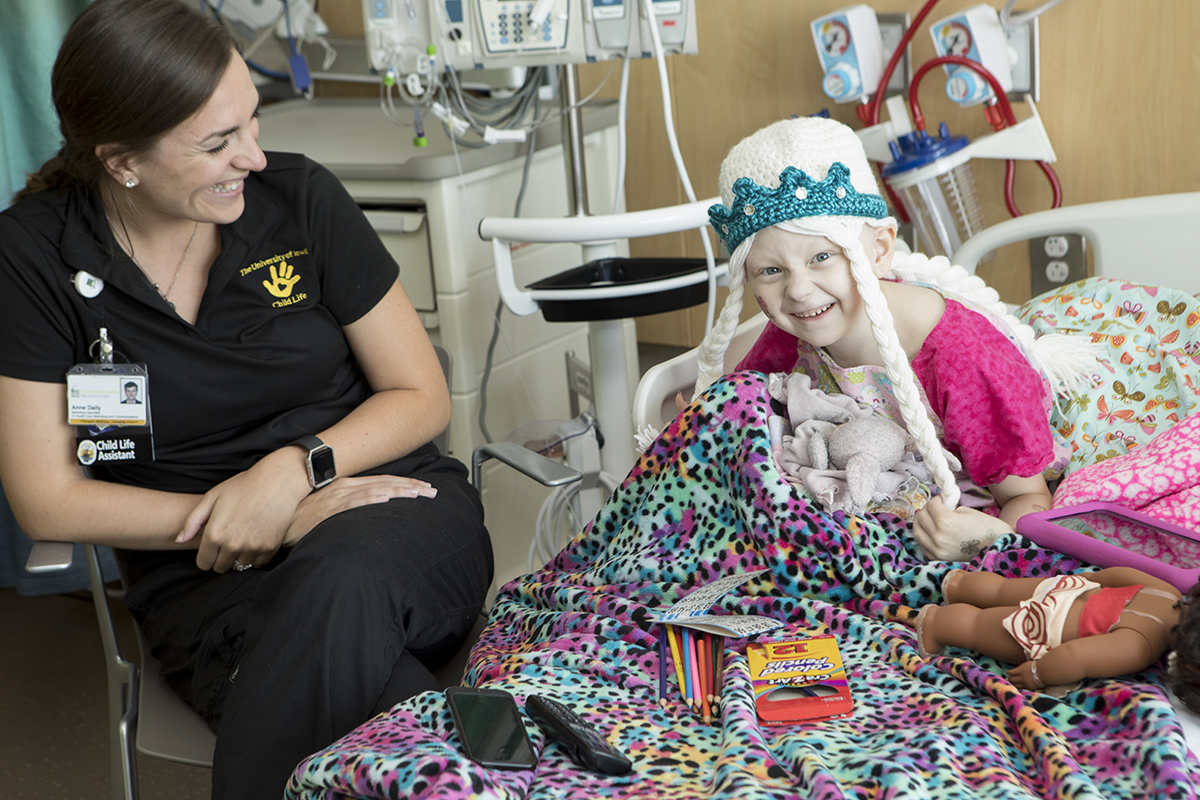
Shaping cancer care…and also careers
Pediatric cancer patients and researchers aren’t the only beneficiaries of Dance Marathon’s efforts. By being involved, countless college kids have learned how to be leaders and found out what it means to make a difference in someone’s life. For some students, participation has opened the door to new career possibilities.
Charlie Ellis, now a senior at Iowa studying enterprise leadership, was the executive director of Dance Marathon 25. He was prodded to check out Dance Marathon in his first year on campus by a student from his hometown of Le Mars, Iowa. He says his involvement has been inspiring and powerful—and has taught him more than he could have imagined.
“I used to be a hardcore perfectionist, but I’ve learned to trust people and ask for help when I need it,” he says. “We wouldn’t succeed if I tried to do everything myself. I’ve learned how to look at things holistically and to understand all the pieces and acknowledge that every single person is vital. Those are skills that will help me no matter what position I am in.”
Kenzie (Hankes) Olson, a 2016 UI graduate, is a certified child-life specialist at Children’s of Alabama in Birmingham, where she helps children and families cope with the stresses of serious illness and make their hospital stays as pleasant as possible. It’s a career she was unfamiliar with as a first-year English major at Iowa.
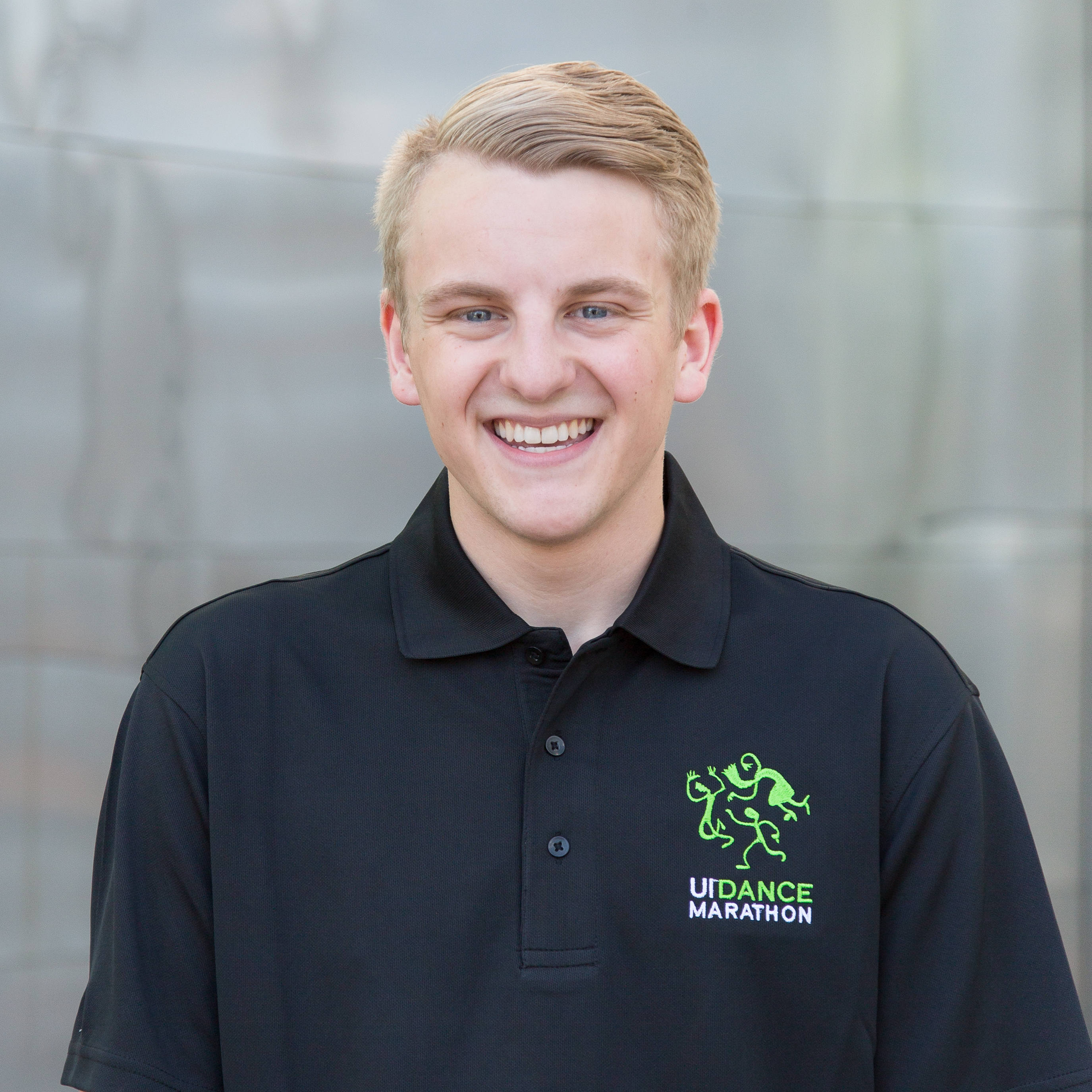
Charlie Ellis
“I knew from an early age that I want to do something helping other people,” says Olson, who had participated in Dance Marathon events at her Dubuque, Iowa, high school before joining the UI effort. “At various times, I considered education, social work, and veterinary medicine. I was also driven to medicine, but I didn’t want to work with needles. It was through my hospital volunteer work with Dance Marathon that I was introduced to the field of child-life specialist, and it fit me perfectly.”
“I’ve learned how to look at things holistically and to understand all the pieces and acknowledge that every single person is vital. Those are skills that will help me no matter what position I am in.”
Because of her exposure to child-life specialists in the UI hospital, Olson switched her major to therapeutic recreation and completed the child-life track. It’s work that she loves.
“A lot of people, when they think of pediatric cancer, see the sad part of cancer,” Olson says. “But lots of kids have fun. We try to make them forget they are in a hospital. They are finding friends and laughing. That said, it can be very emotional and taxing. But it’s also very rewarding.”
Elyse Meardon, a 2009 UI graduate and former executive director of Dance Marathon, serves as managing director for strategic partnerships and Dance Marathon with Children’s Miracle Network Hospitals in Portland, Oregon. She says that among more than 400 Dance Marathon fundraisers organized across the country to benefit Children’s Miracle Network Hospitals, UI Dance Marathon is the third largest. Community support, she says, sets the Iowa program apart.
“UI Dance Marathon has an extremely loyal band of support, all the way to the top ranks of the university,” she says. “That is pretty remarkable. Because of that support, students are able to get into the hospital and get to know the families intimately. The program supports patients, but it also supports students. Not only are students learning the value of philanthropy and how they can contribute to their communities, they get a lot of peer mentoring. It was one of the most formative times of my life.”
Sheila Baldwin, a 1998 UI graduate, was among the first cohort of undergraduates involved in Dance Marathon. The first Big Event, she says, was intended to be a kickoff for the now-defunct spring celebration called RiverFest. It lasted 36 hours, raised some $31,000, and ultimately molded her into a professional fundraiser.
Now, as vice president for health sciences development at the UI Center for Advancement, Baldwin enjoys guiding those who have followed in her footsteps and is proud to see them making substantial gifts. She was in the room when student leaders voted in 2011 to commit $5 million toward the building of a new children’s hospital. She wept.
“Every time Dance Marathon makes that kind of commitment, I get overwhelmed and emotional because it is beyond the wildest imagination of any of us involved at the beginning. I remember in the third year when we first topped $100,000—it felt like we had just climbed a mountain,” she says. “Now, though, my appreciation is less about the sheer number of dollars raised and more about the partner Dance Marathon has become with Stead Family Children’s Hospital and their willingness to take a leap of faith by investing in some projects that other funding sources may see as high risk. They believe in the power they have to fund real change in the way we treat pediatric cancer patients. I think of it as the maturing of Dance Marathon.”
FTK, FTW
At the end of the day, or the year, it’s still about supporting kids and their families as they navigate some of the darkest days of their lives, to give them hope or at least put a smile on their faces. For a mom in Council Bluffs, Iowa, UI Dance Marathon has done just that.
In 2007, Brandy Valyer received a dire diagnosis: her infant son, Brady Jorgensen, had a rare brain tumor known as pilomyxoid astrocytoma. After unsuccessful treatments in Omaha, including surgery and chemotherapy, the family was referred in 2015 to the University of Iowa. Their lives changed.
“Although Brady overcame expectations as a baby, we had hit a brick wall in his treatment and didn’t know what to do. The doctors at UI did their research and came up with a plan before we arrived. That really brought back hope,” says Valyer, recalling her relief when a multidisciplinary team in the UI Pediatric Brain Tumor Clinic proposed a novel plan to target the tumor from multiple angles using narrow beams of radiation.
After 28 treatments over six weeks and return visits every few months, Valyer is cautiously optimistic. Brady is now in junior high, loving math and playing percussion in band. The tumor appears to be stable.
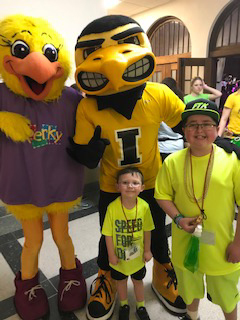
Brady Jorgensen (right) was diagnosed with a rare brain tumor in 2007. His family was referred in 2015 to the University of Iowa. Now, some two dozen treatments and several follow-up visits later, Brady is enjoying life as a junior high student.
“With cancer, there is no end date. It is truly up to the tumor. We call it the sleeping monster,” says Valyer, who also has a 5-year-old son and three stepchildren. “But a lot has changed since that first trip to Iowa City. Now we’re hoping he goes to college. I hope to see him get married.”
With so much uncertainty in their lives, never being able to completely push fear aside, one thing has remained a steady and comforting presence for the family: UI Dance Marathon. It’s not just seeing Brady play Minecraft with Dance Marathon volunteers as the family prepares for yet another hospital procedure or the financial assistance a gift card from Dance Marathon offers at the holidays. It’s also attending the Big Event and feeling part of something bigger.
“Dance Marathon to us is Disneyland. We look forward to it every year,” says Valyer, who attends the duration of the Big Event with her family and has spoken onstage about their health care journey. “This organization raises an amazing amount of money, and I feel proud to be associated with it. With so much negativity, in the news and with cancer in general, it’s good to see so many positives come out of Dance Marathon. It makes you smile. I smile when I talk about it. I’m smiling right now.”
Seeing those smiles is one way DM25 director Ellis measures the organization’s success. But the ultimate goal of Dance Marathon, he says, is “to have zero families, and there is so much work to be done.”
Surely University of Iowa students will be committing their time and energy for as long as that takes, one dollar at a time. Baldwin, for one, doesn’t doubt what Dance Marathon can achieve.
“I believe strongly that when there are major advances in cancer research, it’s very possible that UI Dance Marathon and the dollars they raise will be a part of it,” she says.
